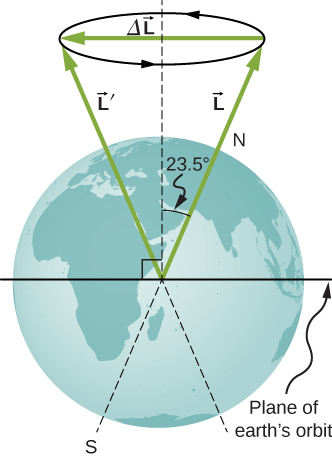| << Chapter < Page | Chapter >> Page > |
| Velocity of center of mass of rolling object | |
| Acceleration of center of mass of rolling object | |
| Displacement of center of mass of rolling object | |
| Acceleration of an object rolling without slipping | |
| Angular momentum | |
| Derivative of angular momentum equals torque | |
| Angular momentum of a system of particles | |
| For a system of particles, derivative of angular
momentum equals torque |
|
| Angular momentum of a rotating rigid body | |
| Conservation of angular momentum | |
| Conservation of angular momentum | |
| Precessional angular velocity |
Gyroscopes used in guidance systems to indicate directions in space must have an angular momentum that does not change in direction. When placed in the vehicle, they are put in a compartment that is separated from the main fuselage, such that changes in the orientation of the fuselage does not affect the orientation of the gyroscope. If the space vehicle is subjected to large forces and accelerations how can the direction of the gyroscopes angular momentum be constant at all times?
A torque is needed in the direction perpendicular to the angular momentum vector in order to change its direction. These forces on the space vehicle are external to the container in which the gyroscope is mounted and do not impart torques to the gyroscope’s rotating disk.
Earth precesses about its vertical axis with a period of 26,000 years. Discuss whether [link] can be used to calculate the precessional angular velocity of Earth.
A gyroscope has a 0.5-kg disk that spins at 40 rev/s. The center of mass of the disk is 10 cm from a pivot which is also the radius of the disk. What is the precession angular velocity?
,
The precession angular velocity of a gyroscope is 1.0 rad/s. If the mass of the rotating disk is 0.4 kg and its radius is 30 cm, as well as the distance from the center of mass to the pivot, what is the rotation rate in rev/s of the disk?
The axis of Earth makes a angle with a direction perpendicular to the plane of Earth’s orbit. As shown below, this axis precesses, making one complete rotation in 25,780 y.
(a) Calculate the change in angular momentum in half this time.
(b) What is the average torque producing this change in angular momentum?
(c) If this torque were created by a pair of forces acting at the most effective point on the equator, what would the magnitude of each force be?

a.
,
;
b.
;
c. The two forces at the equator would have the same magnitude but different directions, one in the north direction and the other in the south direction on the opposite side of Earth. The angle between the forces and the lever arms to the center of Earth is
, so a given torque would have magnitude
. Both would provide a torque in the same direction:

Notification Switch
Would you like to follow the 'University physics volume 1' conversation and receive update notifications?